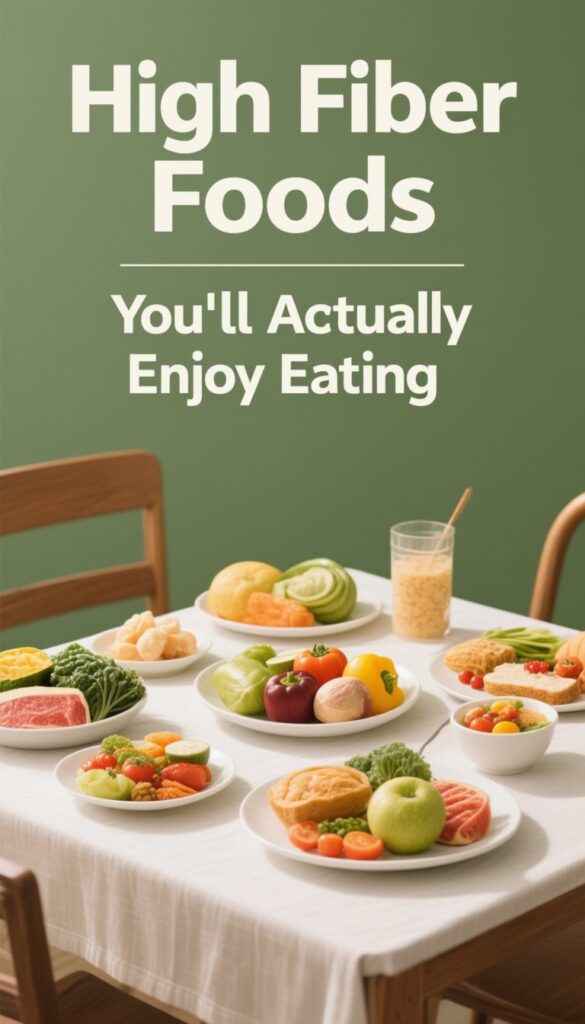Getting enough fiber feels impossible when healthy foods taste boring. Here are 23 delicious, fiber-rich foods that make eating well enjoyable again.
Getting fiber doesn’t have to mean choking down cardboard-tasting foods. You can boost your daily fiber intake with tasty options that you’ll actually look forward to eating. Most Americans only get half the fiber they need each day. The good news? Adding more fiber to your diet can be both easy and delicious.
Fiber helps your body in many ways. It keeps your digestive system running smoothly, helps control blood sugar, and can even lower cholesterol. Plus, fiber-rich foods help you feel full longer, which can support healthy weight management.
Let’s explore 23 amazing high-fiber foods that taste great and fit easily into your daily meals.
Take Charge of Your Health with The Home Doctor
Discover real-world remedies and first-aid solutions you can use when help isn’t around.
👉 Claim Your Home Doctor Guide
Fruits That Pack a Fiber Punch
Apples
One medium apple with the skin gives you about 4 grams of fiber. The skin contains most of the fiber, so don’t peel it off. Apples are perfect for snacking, adding to oatmeal, or baking into healthy desserts.
Pears
A medium pear delivers around 6 grams of fiber. Like apples, keep the skin on for maximum fiber benefits. Pears taste amazing in salads or eaten fresh as a sweet treat.
Berries
All berries are fiber superstars:
- Raspberries: 8 grams per cup
- Blackberries: 8 grams per cup
- Strawberries: 3 grams per cup
- Blueberries: 4 grams per cup
Add berries to yogurt, smoothies, or cereal. They’re also perfect for snacking straight from the container.
Avocados
One whole avocado contains about 10 grams of fiber. This creamy fruit works great on toast, in salads, or blended into smoothies. Avocados also provide healthy fats that your body needs.
Bananas
A medium banana has 3 grams of fiber. They’re perfect for breakfast, pre-workout snacks, or adding natural sweetness to smoothies and baked goods.
Vegetables That Deliver
Broccoli
One cup of cooked broccoli gives you 5 grams of fiber. Steam it, roast it with olive oil, or add it to stir-fries. Broccoli tastes much better when it’s not overcooked.
Brussels Sprouts
These little green gems contain 4 grams of fiber per cup when cooked. Try roasting them with bacon or balsamic vinegar to bring out their natural sweetness.
Artichokes
One medium artichoke provides an amazing 10 grams of fiber. Steam them and dip the leaves in garlic butter or lemon juice for a tasty appetizer.
Sweet Potatoes
A medium baked sweet potato with skin delivers 4 grams of fiber. These orange powerhouses taste great roasted, mashed, or cut into fries and baked.
Carrots
One cup of raw carrots gives you 3.5 grams of fiber. They’re perfect for snacking with hummus, adding to soups, or roasting as a side dish.
Green Peas
Half a cup of cooked green peas contains 4 grams of fiber. Add them to pasta dishes, rice, or eat them as a simple side vegetable.
Whole Grains Worth Eating
Oats
One cup of cooked oatmeal provides 4 grams of fiber. Start your day with oatmeal topped with berries and nuts for a fiber-rich breakfast that keeps you full.
Quinoa
This protein-packed grain gives you 5 grams of fiber per cooked cup. Use quinoa in salads, as a rice substitute, or in breakfast bowls.
Brown Rice
One cup of cooked brown rice contains 4 grams of fiber. It takes longer to cook than white rice but has much more nutrition and fiber.
Whole Wheat Pasta
Choose whole wheat pasta over regular pasta to get 6 grams of fiber per cup. The taste difference is minimal, but the health benefits are huge.
Barley
This chewy grain provides 6 grams of fiber per cooked cup. Add barley to soups, use it in salads, or serve it as a side dish instead of rice.
Legumes and Beans
Black Beans
One cup of cooked black beans delivers an impressive 15 grams of fiber. Use them in tacos, salads, soups, or as a side dish with rice.
Lentils
Red, green, or brown lentils all provide about 15 grams of fiber per cooked cup. They cook quickly and work well in soups, curries, and salads.
Chickpeas
Also called garbanzo beans, chickpeas give you 12 grams of fiber per cup. Roast them for a crunchy snack, add them to salads, or make homemade hummus.
Split Peas
One cup of cooked split peas contains 16 grams of fiber. They’re perfect for making hearty soups that fill you up on cold days.
Nuts and Seeds
Chia Seeds
Just two tablespoons of chia seeds provide 10 grams of fiber. Add them to smoothies, yogurt, or make chia pudding for a healthy dessert.
Flaxseeds
Two tablespoons of ground flaxseeds give you 4 grams of fiber. Sprinkle them on cereal, add to smoothies, or mix into muffin batter.
Almonds
An ounce of almonds (about 23 nuts) contains 3.5 grams of fiber. They’re perfect for snacking or adding crunch to salads and yogurt.
Popcorn
Three cups of air-popped popcorn provide 3.5 grams of fiber. Skip the butter and salt for a healthy, whole-grain snack that satisfies your crunch cravings.
Easy Ways to Add More Fiber
Getting more fiber doesn’t require a complete diet overhaul. Here are simple ways to boost your fiber intake:
Start your day right: Add berries and nuts to your breakfast cereal or oatmeal. This simple change can add 5-8 grams of fiber to your morning meal.
Snack smart: Choose apples with peanut butter, carrots with hummus, or a handful of almonds instead of processed snacks.
Upgrade your grains: Switch to whole wheat bread, brown rice, and whole grain pasta. These swaps can double or triple the fiber in your meals.
Add beans to everything: Toss chickpeas into salads, add black beans to tacos, or mix lentils into soups. Beans are fiber powerhouses that make meals more filling.
Don’t peel your fruits and vegetables: Apple and pear skins, potato skins, and other peels contain lots of fiber. Wash them well and eat them up.
Make smoothies: Blend fruits with vegetables like spinach or kale. Add chia seeds or ground flaxseed for an extra fiber boost.
Tips for Increasing Fiber Gradually
Your digestive system needs time to adjust to more fiber. Add fiber-rich foods slowly to avoid stomach upset, gas, or bloating. Start with one or two new high-fiber foods each week.
Drink plenty of water when you eat more fiber. Fiber needs water to work properly in your digestive system. Aim for at least 8 glasses of water throughout the day.
Listen to your body. If you feel uncomfortable after adding new fiber-rich foods, slow down and let your system adjust before adding more.
Making Fiber Foods Taste Better
Many people think healthy, high-fiber foods are bland. Here’s how to make them taste amazing:
Season everything: Use herbs, spices, and healthy seasonings to add flavor. Roasted vegetables with garlic and herbs taste completely different from plain steamed ones.
Try different cooking methods: Roasting brings out natural sweetness in vegetables. Grilling adds smoky flavor. Sautéing with a little olive oil makes foods more appealing.
Mix textures: Combine soft and crunchy elements. Add nuts to yogurt, put berries on salads, or mix different vegetables together.
Use healthy fats: A little olive oil, avocado, or nuts can make fiber-rich foods more satisfying and help your body absorb nutrients better.
Quick Fiber-Rich Meal Ideas
Breakfast: Oatmeal topped with sliced banana, berries, and chopped almonds
Lunch: Black bean and quinoa salad with diced vegetables and avocado
Dinner: Whole wheat pasta with roasted vegetables and a side of steamed broccoli
Snacks: Apple slices with almond butter, or air-popped popcorn with a sprinkle of nutritional yeast
These meals are not only high in fiber but also taste great and keep you satisfied for hours.
Common Fiber Mistakes to Avoid
Don’t add too much fiber too quickly. This is the biggest mistake people make. Your digestive system needs time to adjust, so increase fiber gradually over several weeks.
Don’t forget to drink water. Fiber without enough water can actually cause constipation instead of preventing it.
Don’t rely on fiber supplements alone. Whole foods provide fiber along with vitamins, minerals, and other nutrients that supplements can’t match.
Don’t remove all the fiber from fruits and vegetables. Juicing removes most of the fiber, so eat whole fruits instead of drinking fruit juice.
How Much Fiber Do You Need?
Adults should aim for 25-35 grams of fiber per day. Most Americans only get about 15 grams daily. That means you probably need to almost double your current fiber intake.
You don’t need to count every gram. Focus on including fiber-rich foods at each meal and snack. If you eat a variety of fruits, vegetables, whole grains, and legumes throughout the day, you’ll likely reach your fiber goals naturally.
Track your progress for a week or two when you start. This helps you understand which foods give you the most fiber and how to plan balanced meals.
The Bottom Line
Eating enough fiber doesn’t mean sacrificing taste or enjoyment. These 23 delicious options prove that healthy eating can be both nutritious and satisfying. Start with the foods that appeal to you most, and gradually add others to your routine.
Remember to increase fiber slowly, drink plenty of water, and focus on whole foods rather than supplements. Your digestive system, energy levels, and overall health will thank you for making these positive changes.
With consistent small changes, you’ll soon discover that getting enough fiber becomes second nature. Your taste buds will adapt, and you’ll start craving these nutritious, fiber-rich foods naturally.

Lifebing is driven by an unrelenting passion for promoting health and well-being, our team is wholly committed to curating exceptional content and immersive experiences.
